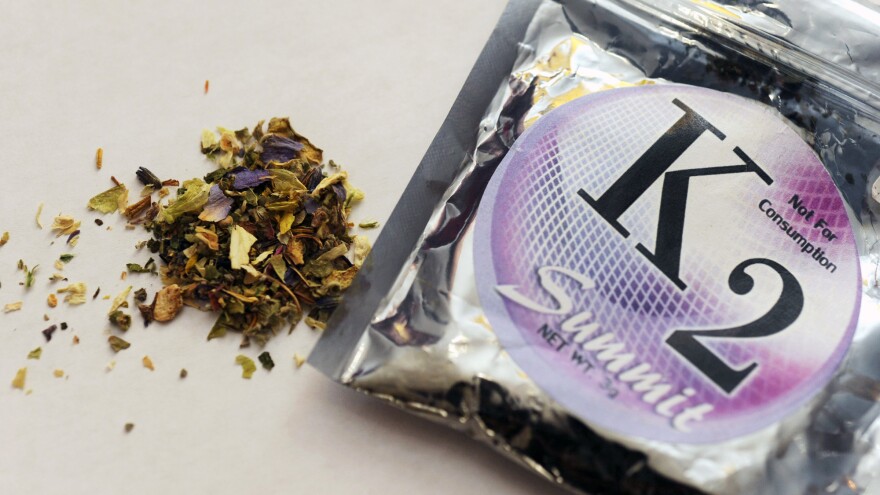Over the past three weeks, people have been tumbling into emergency rooms across the country, seriously ill after using a synthetic drug known as K2 or spice.
Hundreds of cases have been reported in states including Alabama, Mississippi and New York, where state health departments have warned people to stay away from the drug. New York City alone saw over 120 emergency casesin a single week in April.
Several people have died, and emergency room physicians have been seeing K2 users showing up with severe symptoms: high blood pressure, clenched muscles, seizures, hallucinations and psychosis.
"We have to chemically restrain and physically restrain them because they become violent and very strong. It takes four to five personnel to restrain them on a gurney," says Dr. Robert Glatter, an emergency physician at Lenox Hill Hospital in New York City. One patient last week ended up in the ICU. "He was combative and required sedation in the ER."
Although different variations of synthetic marijuana have been circulating on the street for about five years, Glatter says there's likely something unusual about the K2 behind this sudden surge in ER visits.
It's simple for manufacturers to modify the molecular structure of the mind-altering chemicals that producers spray onto dried plant material, which is then smoked. Not only does this make K2 difficult to identify and study, but the psychoactive effects become more unpredictable.
"Chemists are getting more and more creative in designing these structures," says Marilyn Huestis, the chief of a research division at the National Institute on Drug Abuse. That's a big selling part for the drug, which is marketed as a "safe" alternative to marijuana. Changing the molecular structure makes it more difficult to detect in drug screens.
Her division is working on creating tests for several synthetic cannabinoids. But it takes time. "It's like taking a 1,000-piece jigsaw puzzle and throwing it up in the air and piecing it together without a picture," Huestis says. "So here we are in the hospital or police lab, and they have no idea what to look for."
In New York City, Glatter says that this most recent batch of K2 has its users surprised. Many of his patients were longtime users who said they never had to come to the ER because of problems with K2 before now. "They called themselves K-heads and said they'd been doing this for years. I asked one guy, 'What happened?' And he was like, 'I dunno, I use this a lot. I've never had this reaction.' "
If there has been a change in the chemical composition, then Glatter thinks that might account for one striking difference in this outbreak. The high lasts a lot longer. "I had many patients in the ER for four to six hours, which was just unusual. Usually one to two hours and they're ready to go," he says.
"The newer synthetic cannabinoids will have a similar picture to what you're smoking with THC or marijuana," says Dr. David Lee, associate chair of emergency medicine and a toxicologist at North Shore University Hospital in New York. "But if they change the structure, we don't know what else can happen with the newly designed drug."
He says urine samples from this outbreak match at least one known synthetic cannabinoid — a molecule called XLR-11, which caused severe kidney damage to several patients in 2012. But there might be more ingredients that are still unknown, he says. "A few months ago, we had a patient who said he smoked K2 and spice. This patient was very sick, and he had the product with him. We sent it to a laboratory to analyze, and they'd never seen this chemical before. "
In the past few years, laboratories analyzing K2 have found synthetic cannabinoids alongside other compounds. Some sellers spray the synthetic marijuana onto cannabis buds or other psychoactive plants like St. John's wort.
And now they're finding synthetic cannabinoids mixed with synthetic cathinones, a stimulant sold as "bath salts," Huestis says. That includes synthetic versions of piperazine, a medication use to treat pinworm infections that's sometimes used as a cheap substitute for the club drug ecstasy, as well as opioids and benzodiazepines, which are sedatives.
The result is a rapidly evolving product that's chemically far more than just synthetic marijuana. It's like a cocktail of an unknown potency, and consumers can't know what they're getting or how it will affect them. Huestis adds: "What's in it today isn't going to be what's in it tomorrow."
Copyright 2020 NPR. To see more, visit https://www.npr.org. 9(MDAxNDQ2NDAxMDEyNzU2NzM2ODA3ZGI1ZA001))



